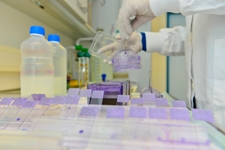Diffuse parenchymal lung disease


The disorder of diffuse parenchymal or interstitial lung disease includes over 100 individual diseases, based on similar pathophysiological origination processes. Among them is progressive fibrosis, characterized by a stiffening of the lung architectur due to increased fibrous connective tissue, which eventually leads to lung failure. Up to now, the only therapeutic option has been lung transplantation. Fibrotic changes can, for example, be triggered by chemotherapy, inhaling toxins or by idiopathic interstitial pneumonia.
The prevalence and incidence of DPLD is often underestimated: almost 750.000 patients in the Western world suffer from DPLD. In Europe, sarcoidosis, idiopathic fibrosis (IPF) and hypersensitivity pneumonitis make up 80% of all adult DPLD patients.
IPF alone affects 150.000 patients in Europe and has an average survival time of 3-5 years after diagnosis. Idiopathic fibrosis represents the most aggressive form of DPLD. Histologically, IPF is characterized by usual interstitial pneumonia (UIP), asbestosis, Hermansky-Pudlak syndrome (HPS) or, for example, amiodarone-induced pulmonary fibrosis.
Furthermore, IPF is virtually resistant to all medical treatment. The last option is lung transplantation. However, here too the long-term outcome is largely limited by chronic rejection processes like, for example, bronchiolitis obliterans.
Scientists in the BREATH research network make a significant contribution to DPLD research, particularly in the field of pulmonary fibrotic research. Particular attention is paid to the validation of microCT imaging as a non-invasive tool for the characterization of the course of disease of pulmonary fibrosis in preclinical animal models. In addition, research is carried out on the role of antifibrotic protease cathepsin K and the general course of disease of pulmonary fibrosis.